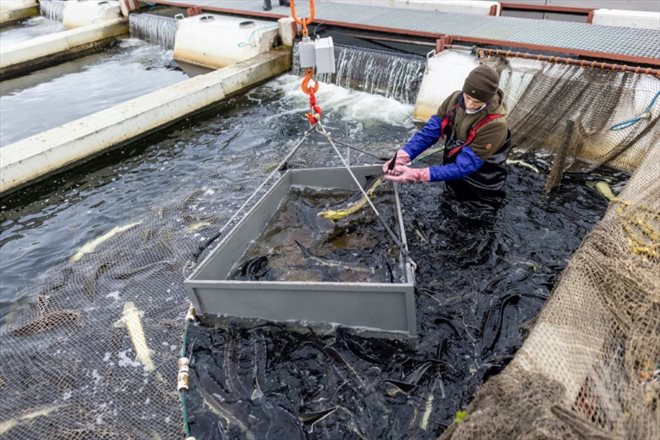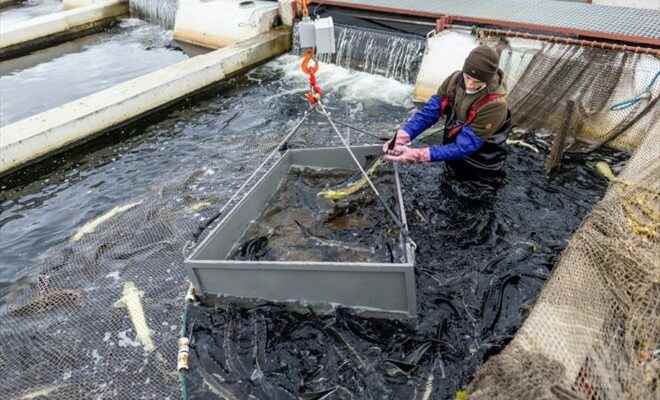Tins of caviar from the Antonius Caviar brand, on November 4, 2022 in Rus, Poland (AFP/Wojtek RADWANSKI)
Caviar, yes, but Polish! One of Europe’s leading caviar producers wants to put an end once and for all to the historic association between the precious product and Russia.
“For most people, caviar is Russia, whereas it has been false for a long time,” Agata Lakomiak-Winnicka, a manager of Antonius Caviar, a company in northeastern Poland, told AFP.
Fished to extinction in the wild – including Russian and Iranian waters of the Caspian Sea – sturgeon now exist almost exclusively on farms, mostly in China.

Sturgeons in a pond at a breeding farm on November 4, 2022 in Rus, Poland (AFP/Wojtek RADWANSKI)
Last year, Antonius Caviar, located in Rus near Olsztyn produced 42 tons of black caviar, behind the Chinese, and ahead of the Italians and the French.
“Eight years ago, it often happened that our customers did not know where Poland was on a map,” recalls Agata Lakomiak-Winnicka, placing a spoonful of fresh caviar on the back of her hand to warm it slightly.

Cans of caviar for export on November 4, 2022 in Rus, Poland (AFP/Wojtek RADWANSKI)
“Today, we are at another stage”, she adds, before tasting the small shiny pearls, gray and black.
The company mainly exports to the United Arab Emirates, the United States, France and Denmark. Its sturgeon caviar retails, depending on the country, for 1,200 to 2,400 euros, for albino caviar the price soars to 8,000 euros.
– “Myth” –
The company also supplies a dozen Michelin-starred restaurants around the world, including three two-star establishments.

Agata Lakomiak-Winnicka, sales manager at Antonius Caviar, on November 4, 2022 in Rus, Poland (AFP/Wojtek RADWANSKI)
Now, like the majority of her competitors, Ms Lakomiak-Winnicka is fighting “the myth of Russian caviar”, while “if you look closely at any box of caviar bearing the inscription ‘Russian tradition’ or ‘Russian method’ , we will see that in 99% of cases it does not come from Russia”.
And since the beginning of the war in Ukraine, it often happens that customers “refuse to buy ‘Russian’ caviar. This is an opportunity to explain that caviar is a product that no longer comes from Russia”, that wild Russian caviar has not been available on the international market for many years, she insists.

Aerial view of a sturgeon farm on November 4, 2022 in Rus, Poland (AFP/Wojtek RADWANSKI)
Indeed, the wild sturgeons of the Caspian Sea and the Volga which produced the precious eggs, were practically exterminated after the fall of the USSR.
Their international trade began to be strictly regulated since the end of the 1990s, including by international conventions.
“The Caspian Sea no longer has any importance in production, confirms the production manager of Antonius, Marek Szczukowski, and almost the majority of the caviar sold in the world comes from aquaculture”. Including in Russia.
In the small store of Russian products in the suburbs of Warsaw, boxes of green and black caviar are displayed in the window.

A box of caviar from the Antonius Caviar brand, on November 4, 2022 in Rus, Poland (AFP/Wojtek RADWANSKI)
On the label, a large inscription “Caviar” is decorated with a drawing of sturgeon accompanied by the word “malossol” which in Russian means “little salty” and designates the traditional method of preservation.
“People have always associated caviar with Russia,” says shop owner Wiktoria Yerystova-Rostkowska, but today because of the war, they don’t want to buy it anymore.
– Boycott of Russian products –
She herself gets her supplies in Germany.

An employee holds a mature female sturgeon at a breeding farm on November 4, 2022 in Rus, Poland (AFP/Wojtek RADWANSKI)
“Customers ask where the caviar comes from. They want to eat good caviar but they don’t want Russian caviar,” she complains.
This boycott of Russian products may force him to close the store in January.
“It’s no longer profitable. I lost 80% of my turnover,” says Ms. Yerystova-Rostkowska.
In the basins of Rus, thousands of sturgeons, some over a meter in length, swarm in the pure, clear water, drawn from a river that flows through the protected forests all around.

An employee separates female stugons from males in a pond at a breeding farm on November 4, 2022 in Rus, Poland (AFP/Wojtek RADWANSKI)
“To leave no doubt, at the express request of customers we are now changing the label,” explains Ms. Lakomiak-Winnicka. Exit the word “Russian” in the name.
From now on it will only be “sturgeon caviar”.
At the top, will always appear, as it has been since the launch of the brand, the inscription: “Proudly produced in Poland”.
© 2022 AFP
Did you like this article ? Share it with your friends with the buttons below.




